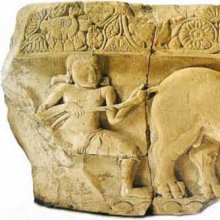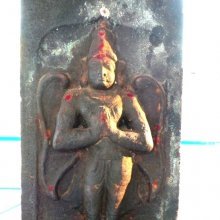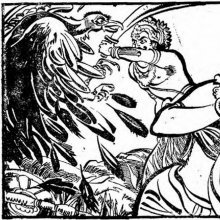Wing: 2 definitions
Introduction:
Wing means something in Hinduism, Sanskrit. If you want to know the exact meaning, history, etymology or English translation of this term then check out the descriptions on this page. Add your comment or reference to a book if you want to contribute to this summary article.
Images (photo gallery)
(+5 more images available)
In Hinduism
Natyashastra (theatrics and dramaturgy)
Source: Shodhganga: Elements of Art and Architecture in the Trtiyakhanda of the Visnudharmottarapurana (natya)The Wing (of a Swan) is denoted by the Sanskrit term Pakṣa, whereas Haṃsapakṣa-hasta refers to one of the twenty-two Single-hand Gestures (in Indian Dramas) (known as asaṃyuktahastas), according to the Viṣṇudharmottarapurāṇa, an ancient Sanskrit text which (being encyclopedic in nature) deals with a variety of cultural topics such as arts, architecture, music, grammar and astronomy.—The word haṃsapakṣa consists of two words viz., haṃsa and pakṣa. The word haṃsa is already explained in the context of haṃsavaktrahasta. It means swan. The word pakṣa means wings. So the word haṃsapakṣa denotes the wings of a swan. In the Viṣṇudharmottarapurāṇa, this hand posture is described as one where the little finger of the hand is lifted crookedly and the thumb is bent.

Natyashastra (नाट्यशास्त्र, nāṭyaśāstra) refers to both the ancient Indian tradition (shastra) of performing arts, (natya—theatrics, drama, dance, music), as well as the name of a Sanskrit work dealing with these subjects. It also teaches the rules for composing Dramatic plays (nataka), construction and performance of Theater, and Poetic works (kavya).
Yoga (school of philosophy)
Source: ORA: Amanaska (king of all yogas): A Critical Edition and Annotated Translation by Jason BirchThe Wings (symbolizing the in and out breaths) are denoted by the Sanskrit term Pakṣa, according to the Amanaska Yoga treatise dealing with meditation, absorption, yogic powers and liberation.—Accordingly, as Īśvara says to Vāmadeva: “[...] When the wings (pakṣa), which are the in and out breaths and whose sphere of operation is all the senses, are cut off, the mind-bird being motionless [in the air], plummets. [The Yogin] becomes joyful like a fish having torn [free from] the mind-net, whose threads are the breath and whose knots are the senses. [...]”.

Yoga is originally considered a branch of Hindu philosophy (astika), but both ancient and modern Yoga combine the physical, mental and spiritual. Yoga teaches various physical techniques also known as āsanas (postures), used for various purposes (eg., meditation, contemplation, relaxation).
See also (Relevant definitions)
Starts with: Wing bean, Wing-leaf soapberry, Wing-leafed wooden pear, Wing-leaved wooden-pear, Wing-rib sumac, Wingbean, Winged bean, Winged bersama, Winged buckwheat, Winged cardamom, Winged dock, Winged java cardamoms, Winged pea, Winged pterygota, Winged ragweed, Winged senna, Winged sumac, Winged-leaved clitoria, Wingleaf soapberry, Wingscale.
Ends with: Angel wing, Bird-on-the-wing, Blowing, Bowing, Crow wing, Drawing, Flowing, Luwing, Owl wing, Ping wing, Pingwing, Redwing, Sewing, Showing, Sowing, Swallowing, Throwing, Tjuwing, Withdrawing.
Full-text (+976): Garut, Patatra, Paksha, Pakshamula, Tanuruha, Pakshati, Vaja, Chada, Dehadhi, Pakshadhara, Pakshapata, Garuda, Pakkha, Mainaka, Bahukuntha, Kakapaksha, Parna, Vajita, Pakshas, Nasaputa.
Relevant text
Search found 217 books and stories containing Wing; (plurals include: Wings). You can also click to the full overview containing English textual excerpts. Below are direct links for the most relevant articles:
Satapatha-brahmana (by Julius Eggeling)
Kāṇḍa X, adhyāya 2, brāhmaṇa 1 < [Tenth Kāṇḍa]
Kāṇḍa X, adhyāya 2, brāhmaṇa 2 < [Tenth Kāṇḍa]
Kāṇḍa VIII, adhyāya 7, brāhmaṇa 2 < [Eight Kāṇḍa]
Taittiriya Upanishad Bhashya Vartika (by R. Balasubramanian)
Verse 2.242 < [Book 2 - Brahmavallī]
Verse 2.274-275 < [Book 2 - Brahmavallī]
Verse 2.311 < [Book 2 - Brahmavallī]
Sahitya-kaumudi by Baladeva Vidyabhushana (by Gaurapada Dāsa)
Text 7.28 < [Chapter 7 - Literary Faults]
Text 10.222 < [Chapter 10 - Ornaments of Meaning]
Text 7.162 < [Chapter 7 - Literary Faults]
The Agni Purana (by N. Gangadharan)
Chapter 242 - Statesmanship fair a king (rājanīti)
Chapter 8 - Manifestation of Viṣṇu as Rāma (part 4)
Chapter 341 - Description of the actions and movements of the limbs
The Jataka tales [English], Volume 1-6 (by Robert Chalmers)
Jataka 236: Baka-jātaka < [Book II - Dukanipāta]
Jataka 35: Vaṭṭaka-jātaka < [Book I - Ekanipāta]
Jataka 476: Javana-Haṃsa-jātaka < [Volume 4]
Apadana commentary (Atthakatha) (by U Lu Pe Win)
Commentary on Biography of the thera Vatthadāyaka < [Chapter 7 - Sakacintaniyavagga (section on Sakacintaniya)]
Commentary on the Biography of the thera Upāli < [Chapter 1 - Buddhavagga (Buddha section)]
Related products








